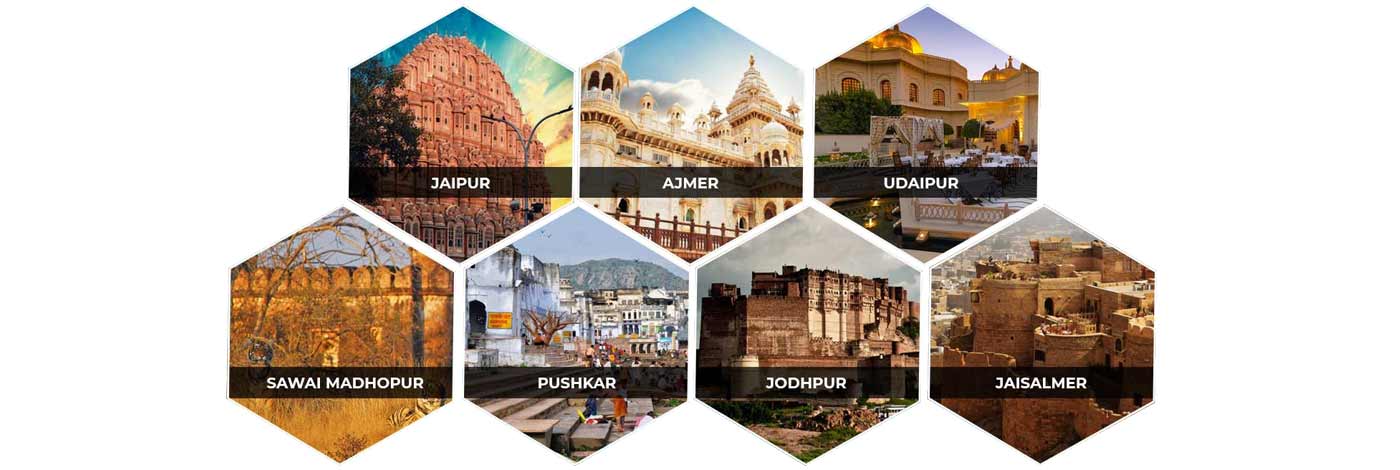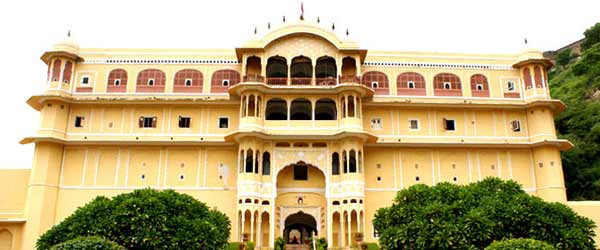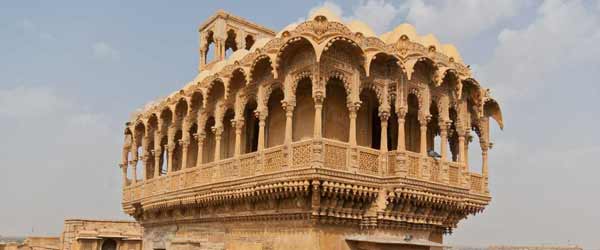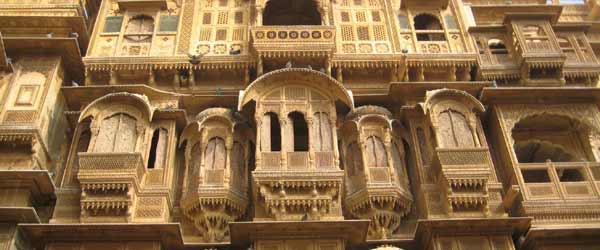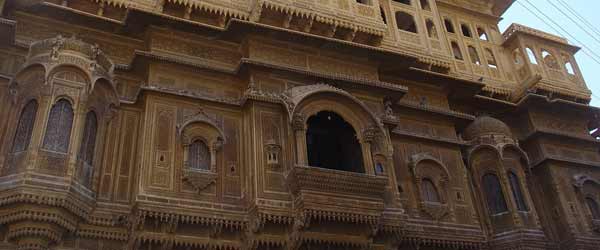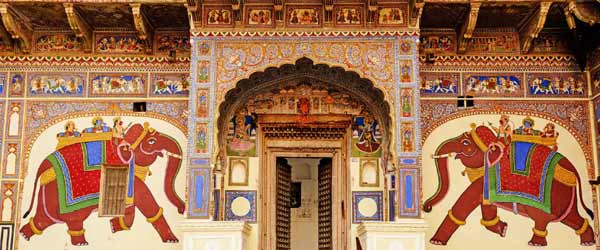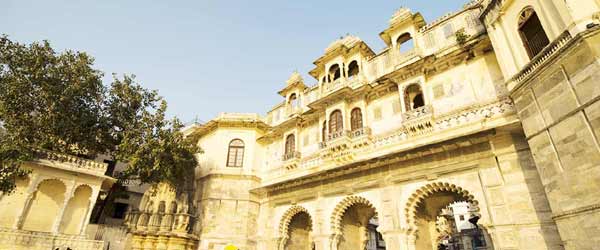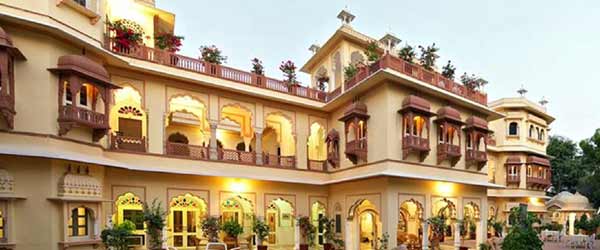
Patwon ki Haveli Jaisalmer
Patwon-ki-Haveli is situated in a narrow lane near the Patwa Complex in Jaisalmer. It is the first haveli to have been erected in Jaisalmer and also one of the top places to visit in Jaisalmer.
The Patwon ki Haveli is considered to be the one of the largest as well as the finest haveli of Rajasthan. This haveli is essentially a cluster of five havelis, which was constructed in 1805 CE by Guman Chand Patwa. A rich trader, Guman Chand Patwa constructed five separate sections for his five sons. The first haveli is the main and also the grandest haveli in the complex. The entire construction took over 55 years to complete.
Located in the center of the city, it is truly an outstanding piece of architecture. It is renowned for its ornate wall paintings, intricate yellow sandstone-carved jharokas or balconies, gateways and doorways. The haveli is built using yellow sandstone and the main gateway is brown in colour. The haveli is five stories high divided into six apartments. The walls also feature beautiful mirror work and several paintings. There is a stunning apartment which is flawlessly painted with beautiful murals. There are about 60 balconies in the haveli.
History of Patwon ki Haveli:
The Havelis are located in a narrow lane hence it is better to walk instead of taking a vehicle there. These Havelis were built in 1805 by a wealthy trader called Gumanchand Patwa. It is believed that he has belonged to a very rich family as they dealt in gold and silver threads which were used in decorating precious clothes of that era.
The Havelis are also known as mansions of brocade merchants for the same reason. Some locals thought argue that the Patwas made their money through opium smuggling and money lending. Gumanchand Patwa built these Havelis over 60 years. But looking at the structure, one will be compelled to think that every single year and every single piece of stone put in these buildings intensifies the magnificence of these beautiful Havelis.
Currently, the Havelis are used by the government of India. The office of the Archaeological Survey of India and the Rajasthan state arts and craft department is situated in these Havelis. The most beautiful Haveli in all of these is the Kothari Patwa which is also the most popular one.
The individuality of each Haveli is depicted through different styles of mirror work and paintings on their arches and gateways. Colorful murals adorn the walls of these mansions. Such is the brightness of the color that you are bound to feel mesmerized seeing the beauty of these murals.
Apart from the walls these murals also decorate the Jharokhas, balconies and the entrance gates of each mansion. Such beauty is rare to be found even in Rajasthan. The famous Rajasthani artwork is shown in its full glory in these mansions. If your art buds are still not satisfied, then there is a museum which has on display the numerous paintings, sculptures, and artifacts which could be used as eye soothers.
Feel the luxury and royalty of the Patwas in this museum, I am sure that even the kings of Rajasthan would have envied these wealthy traders. An Important historical fact is that the Patwon Ki Haveli was only the second Haveli to be ever built in Rajasthan and the first was one in Jaisalmer.
The pillars and ceilings of these beautiful mansions contain intricate carvings that depict the craftsmanship of artisans of that bygone era. Such is the detail of sculpture that you can identify the figures even after 200 years, isn't it amazing. The artisans have expressed themselves even on the archways and main gates, which are filled with these wonderful specimens of art.
Architecture students arrange special visits to the Patwon Ki Haveli to study the nuances of the art. Architects of these mansions kept the special provisions to ensure that the residents do not feel the infamous Rajasthani heat. These mansions contain over 60 balconies, from where the courtyard is visible.
Beautiful windows are donning the entire structure and providing enough ventilation to the residents which save them from excessive heat. The Jaisalmer Fort, Patwon Ki Haveli, Sam Sand Dunes are most important places to visit in the town of Jaisalmer.
Haveli in Rajasthan
Rajasthan Havelis is named after the Rajputs who were kings as well as brave soldiers. They have created a much spectacular building where they used to stay popularly known as Havelis, which helped as a resident for the royal family.
These monuments are evidence of the remaining example of the state rich architectural heritage. The much-talked Havelis of Rajasthan are Samode haveli, Patwon Ki Haveli, Nathmalji Ki Haveli, Shekhavati Haveli, Mandawa haveli and many others.
History of Havelis in Rajasthan
From 1830s Haveli became an important building in Rajasthani regions of Shekhawati and Marwar. The marwaris used to commission artists to paint the havelis. These were a status symbol for the merchants and traders. These were also the dwelling places of the joint families that offered comfort away from the day-to-day tensions of the world. There would be one large gate at the entrance and the mansion would be closed from the other sides. These were spacious abodes that were richly decorated.
Features of Havelis in Rajasthan
The main features of these havelis were chhajjas (sunshades), jharokhas (balcony windows) and jalis (screen windows). These huge mansions were usually built around a courtyard with darwazas done in beautiful architectural elements. The marwari havelis of the Shekhawati region have murals with remarkable colours. The motifs on the walls are varied from everyday scenes and subjects inspired by the west. An amazing feature of these havelis was the intricately carved wooden doors.
Architecture of Havelis in Rajasthan
The havelis of Shekhawati consist of 2 courtyards - an outer one and an inner one. The outer courtyard is for men. The inner courtyard (aangan) is exclusively for women. A large Haveli with two or three stores can have three to four courtyards. The towns and villages of Shekhawati are renowned for the frescos on the walls. One of the most well known Haveli in this regard is the Patwa havelis of Jaisalmer. The stone carved jharokhas are a major tourist attraction here.
Other places where one can come across grandiose havelis are Churu, Jhunjhunu and Sikar. The havelis were mainly painted in blue, yellow, green, indigo and maroon. With the advent of the 19th century the motifs on the walls underwent a change. New themes of telephones, trains, cars, balloons, British hunters, gramophones, the paintings of the Haveli owners became popular.
Famous Havelis in Rajasthan
From Jaipur to Jaisalmer and from Bikaner to Jodhpur, the colourful Havelis in Rajasthan tell again the magnificence and splendour of the former times. Tourists often plan their tour to Rajasthan to get a sight of these Havelis in Rajasthan. Following are the famous Havelis in Rajasthan:
 +91 9549279999
+91 9549279999 